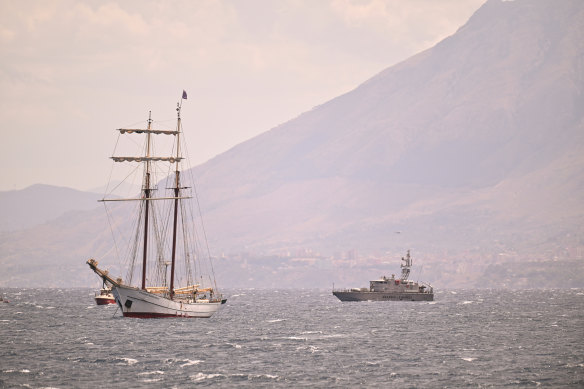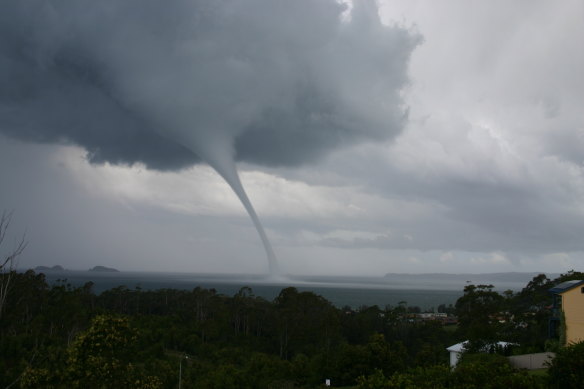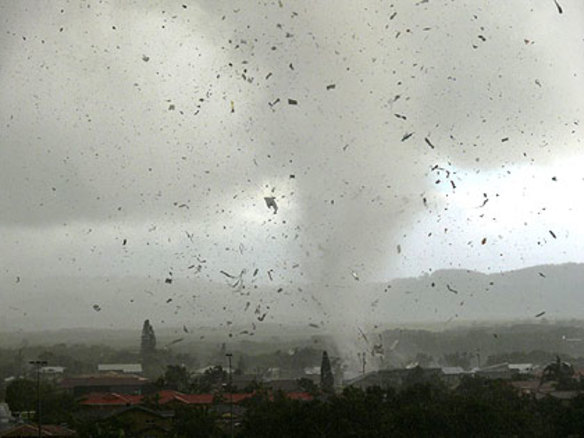This was published 10 months ago
The deadly storm that sank a superyacht: What is a waterspout?
By Angus Dalton
Police, cave-diving specialists and an underwater rover are searching for six people missing off the coast of Sicily after a suspected waterspout smashed and sank a 56-metre luxury yacht.
A tech tycoon dubbed the British Bill Gates, Mike Lynch, was on board the Bayesian celebrating his acquittal from fraud and conspiracy charges.

A coastguard vessel and a private sail boat assist the search for missing passengers after a yacht, the Bayesian, capsized off the coast of Palermo, Italy.Credit: Getty Images
He and his daughter are among the missing and one man is confirmed dead, while 15 survivors are recovering after escaping the sinking vessel on a lifeboat.
So what’s behind the suspected “black swan” waterspout that fatally struck the Bayesian?
What causes a waterspout?
Waterspouts are whirling columns of air and water that usually form over the ocean. There are two kinds of waterspout: fair-weather and tornadic.
The fair-weather spouts are triggered when winds blowing in different directions meet; particularly cool air flowing from land over warm ocean water.

A waterspout spinning off Batemans Bay.
The influx of warm air meeting cold becomes a rotating wind. From the surface of the ocean, the only way is up.
The rising, spinning wind gathers speed, and water vapour sucked up from the ocean becomes a visible vortex as the spout reaches maturity and connects to the cumulus clouds above.
Fair-weather spouts are dramatic yet short-lived, lasting for only five to 10 minutes. They’re not particularly dangerous, but the Bureau of Meteorology warns winds inside the spout can reach 100km/h and inflict serious damage to boats.
Can waterspouts turn into tornadoes?
Fair-weather waterspouts don’t turn into tornadoes, but the second category of waterspouts – the tornadic variety – are essentially just actual tornadoes that form over the ocean.
They’re the fair-weather waterspouts’ destructive cousin. Tornadic waterspouts can hit 400km/h, are associated with hail and lightning, and may be the culprit behind the Bayesian’s sinking.
While fair-weather spouts form on the ocean’s surface and stretch up to meet the clouds, the tornadic kind emerge from supercell storms in the sky and develop downward.

Debris flies as a waterspout sweeps into Lennox Heads.Credit: Ross Tuckerman
They’re much better at surviving landfall and can inflict serious damage.
Do they happen in Australia?
Tornadic waterspouts are rare in Australia but there are instances when they’ve made landfall and ripped through homes and infrastructure.
In 2010, a tornadic waterspout destroyed dozens of homes in Lennox Head, and in 2015 a similar vortex tore through Kurnell, damaging Sydney’s desalination plant and sucking a worker out of a control-room window.
And the Bayesian incident isn’t the first time the tornadic vortexes have wreaked havoc for yachts. A massive waterspout smashed through the Sydney to Hobart in 2001, tearing the mainsail of the maxi yacht in the lead.
Non-tornadic waterspouts can be dangerous, too. In April this year, one made landfall in Green Point on the Mid North Coast, hurling barbecues and trampolines into the air and damaging dozens of homes.
But it’s very rare for fair-weather waterspouts to maintain their energy once they hit land. Usually, they’re spotted far out to sea spinning above warm waters off NSW and Queensland.
They’re more likely in autumn and winter, says the bureau, because air over land is colder while the ocean stays relatively warm.
In 2022, unusually warm water off the Illawarra coast generated a twirling line of six waterspouts. It’s not uncommon for multiple waterspouts to form at the same time along the “convergence line” where two winds meet.
Can waterspouts be predicted, and are they becoming more common?
Because they’re relatively small and short-lived, it’s almost impossible to predict when a waterspout will strike.
As opposed to rain events, which are easy to pick up on radar, we don’t have much data on the formation of tornadoes and waterspouts, Professor Jason Evans from the Climate Change Research Centre at UNSW said.
“I would say that’s a massive gap in our knowledge,” he said. “We don’t even have a good handle on how frequent they’ve been in the recent past.”
Generally speaking, warmer ocean temperatures intensify storms, he said. The president of the Italian Meteorological Society, Luca Mercalli, has tied the tragedy in Sicily to climate change, saying temperatures spiking 3 degrees above average in the Mediterranean Sea added volatile energy to the weather system.
“Thirty years ago an event of this kind might have brought winds of 100km/h,” he told The Guardian. “Today it’s 150km/h because sea temperatures of 3 degrees higher means an enormous quantity of energy for storms, and when cold air arrives it’s explosive.”
At least one study has found the frequency of waterspouts is increasing with warming water. Like the Mediterranean, the ocean off south-east Australia is a global warming hotspot, with water warming three times the global average.
What authorities think happened to the Bayesian in Sicily
The Italian coastguard said a “violent storm” hit the small harbour of Porticello, near Palermo, in the early hours of Monday morning (local time), where the Bayesian had dropped anchor.

Scuba divers study a map of the sailing yacht Bayesian at the Porticello harbour.Credit: AP
Authorities believe a waterspout spiralled up in the exact location of the Bayesian, potentially dumping an enormous volume of water onto the deck.
“That water carries significant weight,” Matthew Schanck, chairman of the Maritime Search and Rescue Council, told The Times. “If the waterspout ends up dumping a load of that water on board the vessel, that’s going to cause significant damage.”
The Times dubbed the waterspout a freak “black swan” event.
Sicilian prosecutors are investigating whether portholes and hatches were left open overnight, allowing water from the spout to rush into the vessel. Sailing expert Skip Novak told AP he believed gusts may have pushed the yacht over, allowing ocean water to gush through open internal doors.
“This just doesn’t happen. You know, boats sink because things like keels fall off, or they run aground and breach the hull,” he said.
“From a weather angle, a boat that big being pushed over on its side is absolutely extraordinary.”
The Examine newsletter explains and analyses science with a rigorous focus on the evidence. Sign up to get it each week.